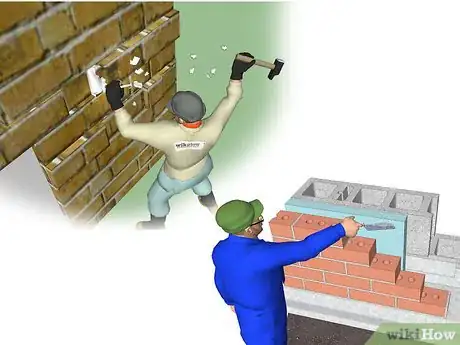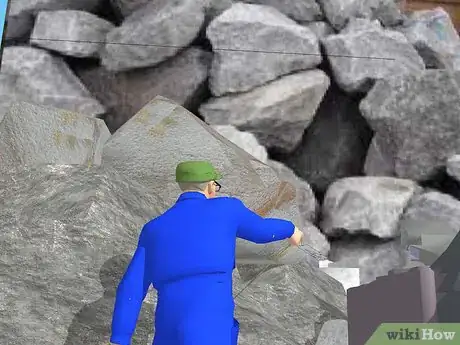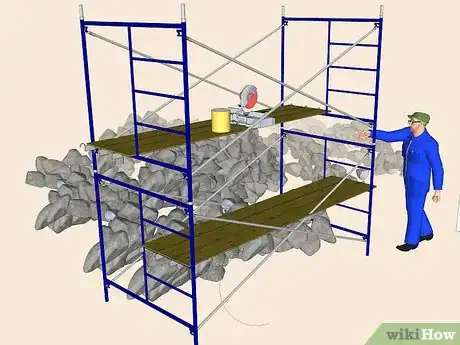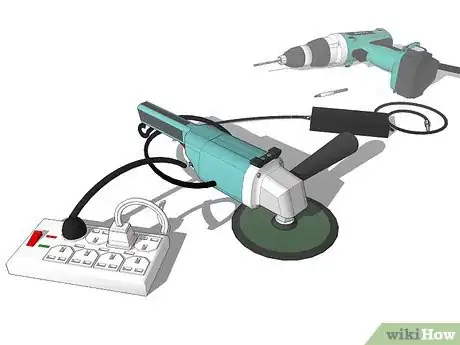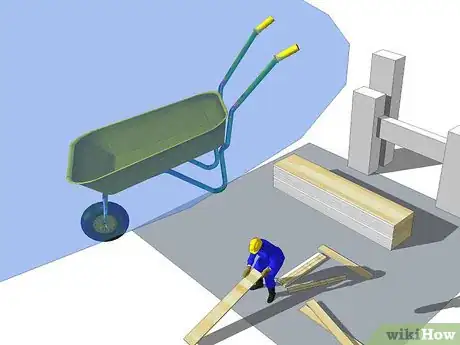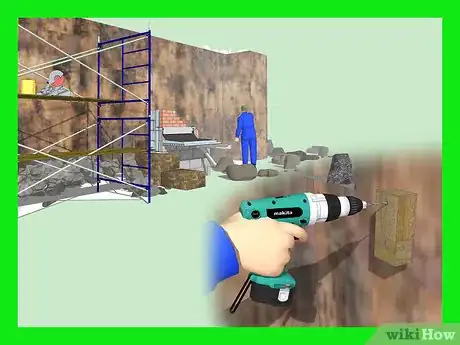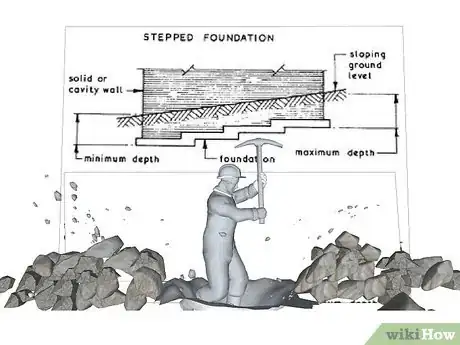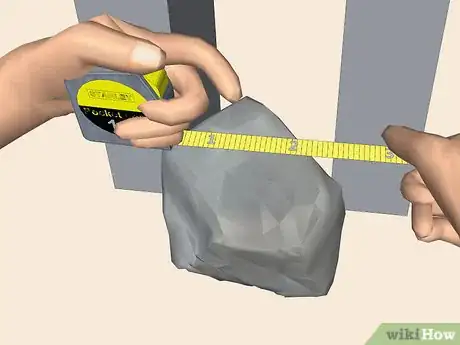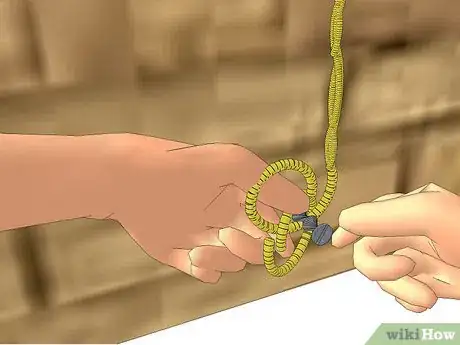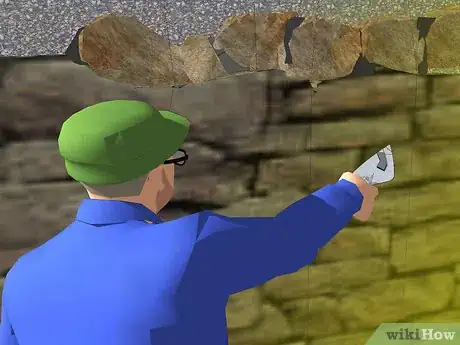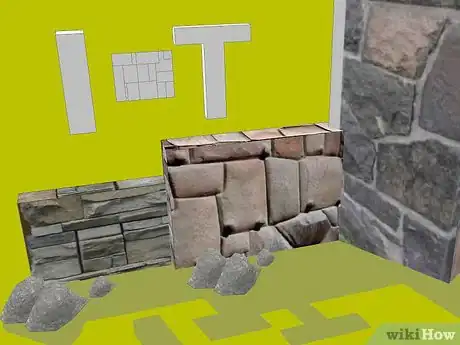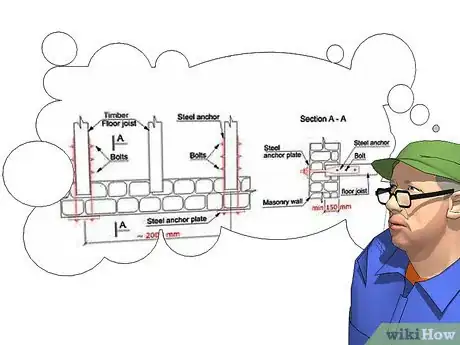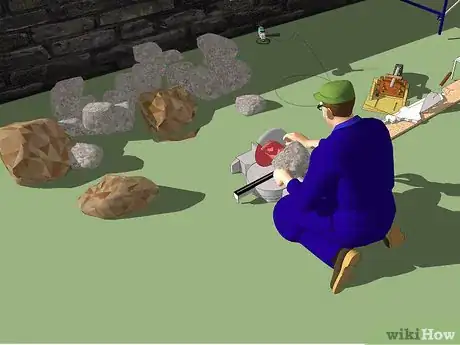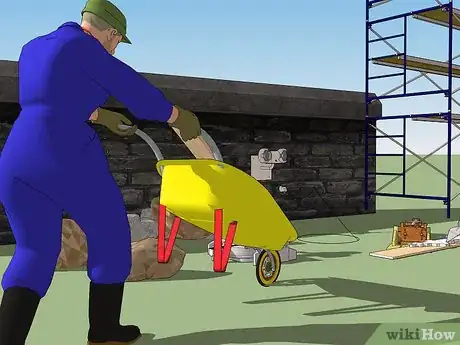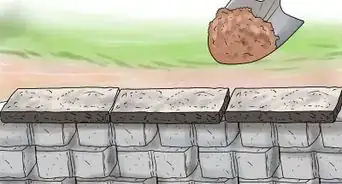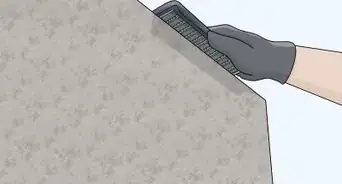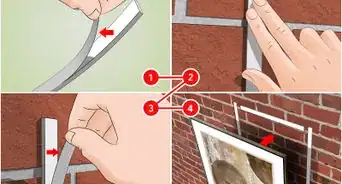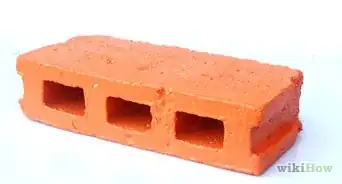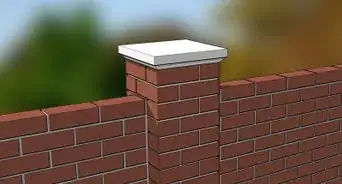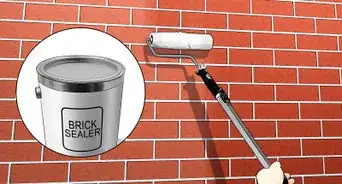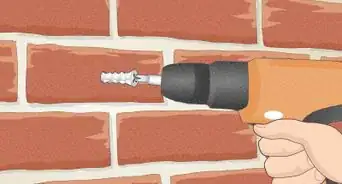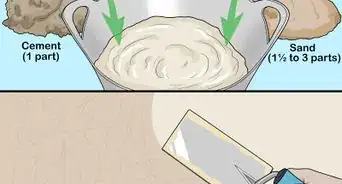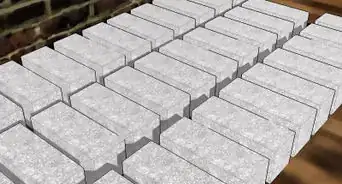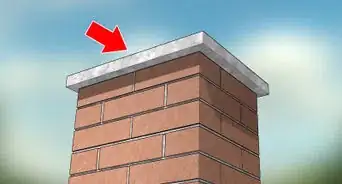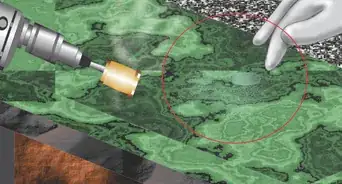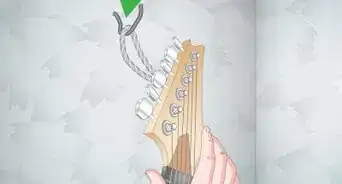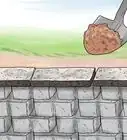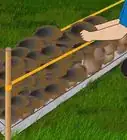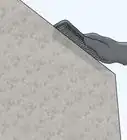X
wikiHow is a “wiki,” similar to Wikipedia, which means that many of our articles are co-written by multiple authors. To create this article, 19 people, some anonymous, worked to edit and improve it over time.
This article has been viewed 135,728 times.
Learn more...
How to be a stonemason. This is a guide that'll walk you through the process of becoming one of the best stonemasons, and includes brilliant tricks of the trades.
Steps
-
1Know the difference between a stonemason and other related trades.[1] A stonemason is completely different from a brick layer, block layer, tile setter, and a "phony stonemason"; "phonystone" is exactly what its name implies it to be - a phony or a fake.
Phony brickwork will mostly consist of concrete and a fake thin film that's completely worthless and will flake off in a matter of 15 years or slightly longer. Stonemasons actually work with real stone. -
2Learn how to do wall rock. Wall rock is the type of work stonemasons do the most. Separate the two words "wall" and "rock", meaning you're putting rock together with "mortar" in order to make a wall.Advertisement
-
3Construct a cutting operation. Usually this is done with two scaffolds and an X-brace and about three planks. Two should be at about hip level and one at the top of the scaffold, so that you can put a bucket full of water up top.
This is so that you can create a siphon for your wet saw, should you need it. It's usually safe to assume you'll need it every day. -
4Get your tools and plug them in and place them where you'll need them. Sometimes you won't need all your tools but take out the ones that you'll need with that specific job. If you don't know which tools you'll need, take all of them.
-
5Consider where your cement is going to be coming from. If it's not smart for you to have a wheelbarrow full of cement, get a mud board. A MUD BOARD can usually be found on every job site. It's just any flat board that you wet down and place cement on.
-
6Get a good amount of stone and adorn it all around your cutting operation. You want a good selection to work with, but don't take all the good stones if you have other stonemasons on the job that could use some. Just use those really good ones you might need and leave it at that.
-
7Before you mix any cement, look at your wall and think about what you might need. If it's a pillar or something that has a corner, then you're going to have to string a line or a series of lines. This means you'll need a tightly strung string that is strung from above where you're working and all the way down to the bottom at a specific measurement.
So suppose you're wrapping your stone around a pillar and your distance is two and a half inches away from the wall; cut a 2x4 at about a six inch length. Then get some particle board and cut it in a long strip.
Drill the six inch long 2x4 to the particle board with two screws so that the tension in the line doesn't cause the 2x4 to pivot. Drill the particle board to the wall.
Measure from the two walls two and a half inches and make those measurement marks on the 2x4. Extend those marks with a square to the point to where the measurement marks intersect.
Drill a screw into that intersection point, but don't drill it 100% into the wood. Leave some of the screw out a little ways.
Now, tie a stiff and durable string to that screw you just drilled. Make sure that the string reaches all the way to the bottom with a little extra remaining. -
8Dig all the way down to the foundation or footing of the structure you're going to be working on. If there's not enough of a footing, then you'll have to dig about a foot deep and pile in some stiff cement into that hole in order to make your own footing.
-
9Lay your first stone at the corner. Make sure it's at two and a half inches out on both ends of both walls. You can do this with a square and a measuring tape to make sure the edge of your stone is at the proper measurement.
When working with corners, you'll usually need a natural edge or a chiseled edge. Make sure not to leave a saw cut edge on the rock, unless you're told to do that by your employer... but you're not likely ever to encounter that situation. -
10Get another screw and tie it to the bottom end of your string. Make sure it's tight enough so that when you tuck it underneath your first cornerstone you'll have tension on the line, but it won't lift your stone up off the ground because the cement is still wet.
If this is the first time you're doing this, you'll get frustrated with this process. You'll learn how to do it right in time. -
11Try to make sure that the line isn't off. Measure, measure, measure, re-measure, and measure again. When working with corners, this is the most vital thing.
If it's off, then you might have to tear out two to three days of work - if not more - which obviously sucks if you're paid by the square footage and sucks even more when you're being paid the the hour because then you're in danger of losing your job for pay that wasn't delivered to your employer.
So make sure you measure as much of everything that seems important and even some of the things you'd usually not consider. Just measure, measure, and measure some more. It's hard to get to the point to where you're measuring too much. -
12Keep your joints as tight as can be. Sometimes this means you need to undercut some of your stone and not just cut straight down on your rock. Don't undercut at a too dramatic angle but just enough to fit your stones nice and snugly together without having one overlap the other.
Make sure every stone is flush - unless your employer wants a Rustic look. (The way to tell if you're a good stonemason is to see if you're organized and that your work meets customers expectations.) -
13Be aware that there are going to be points in time when you're working with rather tight fits and difficult cuts. For example, you'll be picking up this big heavy stone and moving it around and making marks on the stone and cutting it a little bit, then repeating this process in order to finally lay the stone.
The more you play with a stone, the more likely it's going to break. So you can either work with lots and lots of small rock, or you can use a template. This is a trick of the trade!
Buy some wire that's not tie wire. (Tie wire is too stiff, you need some wire that you can move and shape easily; usually this means having a thinner caliber of wire. However, if it's too thin it won't hold its shape and it'll sag and waste your time.) Find a brand of wire that you're comfortable with.
Get a good length of wire, cut it, then wrap the two ends together. You should have a circular-looking type of wire. Put it in those difficult to cut places and shape it to the shape the outer portions the shone should be. Shape it so that it's not touching any of the already laid stones. Spend an extra minute or two just to make sure it's right.
Working a little longer on a light piece of wire is much faster and easier than having to pick up a heavy stone, mark it a little bit, cut, then mark again, and cut, and repeat this process however many times is necessary to get it right. Hopefully you've shaped the wire properly.
Place it atop your stone. If you have a pencil or Sharpie marker, place the wire onto the stone and mark it from the inside of the wire. (Make sure you don't invert your template, otherwise your stone will be worthless.
Sometimes you can salvage it by flipping the stone, but if you undercut it probably won't be; so there are downsides to undercutting, but it does more good than bad). Once you've marked your stone, put your stone to that shape and it should fit perfectly into place. -
14While doing stone masonry, make sure your joints are T's or I's. Try never to make an X joint. Let me explain. You've seen how bricks are stacked, right? Each layer is staggered.
Suppose they weren't staggered. You'd wind up with a bundle of X joints. If they were a map they'd be four-way stops rather than T intersections. These are bad. They look ugly and usually cause a running joint.
A running joint is a joint that extends more than three feet. Those are bad. Why? Because as the stonemasonry ages sometimes cracks form. The first places cracks form are in X joints and in the running joints. -
15Keep in mind that there is more to this job. There is always a quirky little thing that you'll have to work around. Hopefully you can work around the problems presented to you with reflection and perseverance.
-
16Proceed to master flat work. Flatwork means working on floors. This is faster, meaning that more gets done in one day and you get paid more for it; but you rarely do it, so worship the employer that gets it.
-
17Set up your cutting operation. I suppose you can use scaffolding, but it's usually smarter to just use a wheelbarrow. With that wheelbarrow, get a particle board that extends the length of the thinner area of the wheelbarrow and lay it down. Get your grinder or wet saw out and place it there. That's your workspace.
-
18Find out what pattern you're doing. Start laying your stones. Obviously there are going to be some complicated cuts involved.
- Get some plastic transparent tarp that's inexpensive. Sometimes it's stuff that's usually used for masking or stuff that you'll just find around, or you can buy . Buy some Sharpie markers, too. Place the tarp around the place that you're going to cut. Be sure to stretch it out. Mark the shape of the stone you're going to cut. Write TOP in the middle of the plastic template so that you don't invert the stone. Find the appropriate stone that's the right size for the template. Put some water on your stone and place the plastic template on the watery surface so that it doesn't blow away or move. Cut the stone to the shape you need it.
Advertisement
Warnings
- Beware of X joints. It's best to keep joints about 4 inches (10.2 cm) away from each other. Also, beware of running joints.⧼thumbs_response⧽
Advertisement
Things You'll Need
- Hammer: The hammer should be an eight pound sledgehammer, not some dinky carpenter's hammer. The weight helps increase the amount of force thrust on the chisel, which creates clean and controlled breaks in the stone.
- Chisels: There are two types of chisels. Of course, there are many different shapes for different purposes for different breaking of the stone, but I'm talking about grades of chisels. There are chisels you can buy at essentially any Home Depot or Lowes that are entirely made out of steel. These are "okay". They get the job done. They're usually used the most because they're expendable, however there are downsides to using these. You have to constantly check to see if they're sharp. If they're not sharp then you'll break the stone improperly, which can sometimes set you back about an hour or two and most stonemasons are paid by the square foot, rather than by the hour. Now, the second type of chisel are those called Carbon Tipped Chisels. These obviously have a special tip that never dulls. The downside is that they're expensive and because they're so pricey, you'll only want to use them when you're doing something complicated with a stone but you'll still have to be familiar enough with them that you'll know the proper techniques to not screw up.
- Trowel: A Marshall Town or a Rose is recommended. Both of these are high quality. Just get a conventional bricklayer's sized trowel. Cut a somewhat forty five degree angle off the trowel about four inches down from the tip - this is so that you can move mud around more efficiently, scoop more cement out of the bucket at one time and scrape it out of the bottom with ease.
- Grinder: this is essential. The best brand can only be purchased at The Home Depot. It's a Ridgid grinder. Basically, they're so good because when they lock up, they react in such a way that they don't burn up the engine; they just last longer and they're a great thing. If you want details about it then go to Ridgid.com and read up on them yourself. All Ridgid tools are pretty good. They're a little pricey, but they'll last long enough to make your money well spent. Anyway, grinders are helpful. It's best to use them outside because they kick up quite a bit of dust and you don't want to breathe that indoors. The downside is that you probably shouldn't cut stone any deeper than a half-inch, otherwise you'll overheat the diamond blade and chip it, cause the grinder to bind up and overwork its engine. The only time cutting deeper with a grinder is ok is when you're squirting a constant stream of water on the blade as you're cutting the stone but usually there are other tools for deeper cuts. Usually a deep scoring of the stone is all that's truly needed. Sometimes you need to cut deeper, or even all the way through the stone and you'll know when you'll need to do that. But usually a deep score will cause a weakness point in the stone to the point where if you strike the stone with a hammer and chisel on the score, it'll usually break along that scoring. Just be smart about how hard you hit and where you hit. It's not rocket science, but it's not easy all the time.
- Wet Saw: Most stonemasons make their own. They buy a conventional old saw and purchase a syphon kit and custom tailor it to work. The reason for a wet saw is so that you can cut all the way through stones as as to not kick up dust everywhere, but they're wet so they're a little messy. They're great for working indoors, but you'll usually have to cover up your surrounding area so that it doesn't get dirty. These are also great when you need really deep cuts in really thick stone.
- Blades: So what's a grinder and a wet saw worth if you don't have a diamond blade? Purchase Cherokee blades. They last a long time. They're usually a little pricey, but they usually are a high enough quality to make your money well spent. They're usually reliable.
- Hammer Drills: These are handy. They save time and they're efficient. There's a technique in using them and that's to keep it in motion.
- Drill: A hammer drill and a drill are completely different. Hammer drills put bursts of FORCE on and off on during their use, and they're usually heavy duty. You'll just simply need a normal drill - a cordless one is best as the more cords you have all over the place, the longer it takes to get the day started and finished; cords cause more work because you have to pay more attention to avoiding them and that will irritate you because cords are the last thing you want to worry about as you're working along. These will be mostly used in putting in wall ties.
References
About This Article
Advertisement
